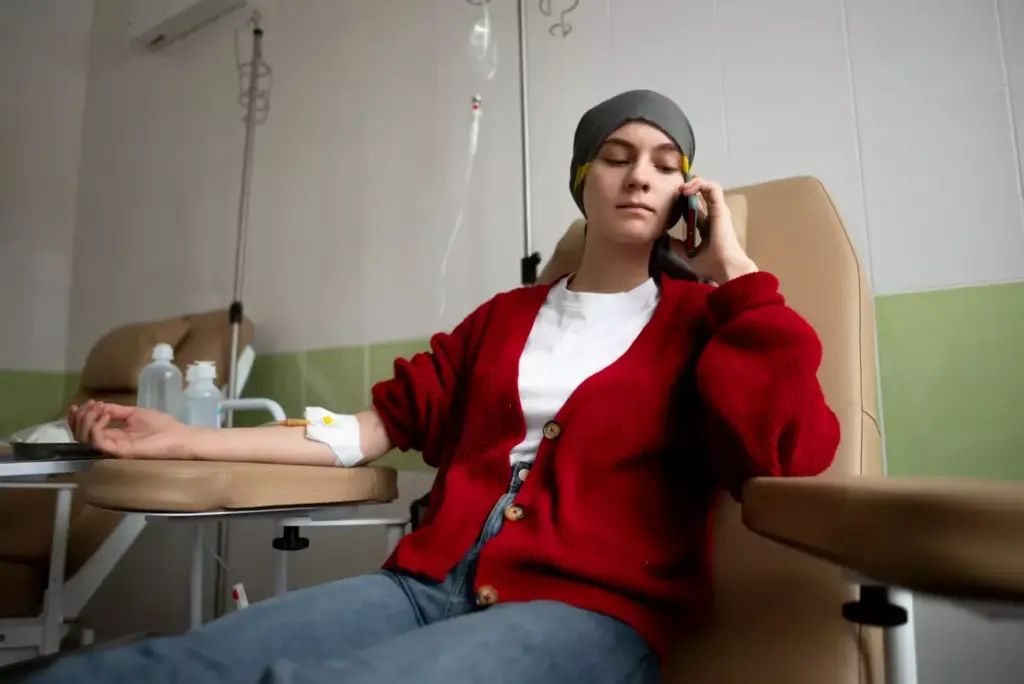Last Updated on November 26, 2025 by Bilal Hasdemir

Breast cancer remains one of the most common cancers worldwide, with chemotherapy playing a central role in both early-stage and advanced disease management.
At Liv Hospital, we leverage the latest evidence-based chemotherapy regimens tailored to individual needs, ensuring both efficacy and compassionate support throughout the journey.
New developments in chemotherapy treatments, such as antibody-drug conjugates, are being researched for their potential to deliver treatment directly to tumor sites, reducing side effects.
We will introduce the importance of various chemotherapy drugs and their selection based on tumor characteristics and patient health.
Key Takeaways
- Understanding chemotherapy options is crucial for breast cancer patients.
- Liv Hospital offers internationally recognized, patient-centered care.
- New chemotherapy treatments are being researched to reduce side effects.
- Chemotherapy regimens are tailored to individual patient needs.
- Combination therapies maximize effectiveness in breast cancer treatment.
The Role of Chemotherapy in Breast Cancer Management
Chemotherapy plays a crucial role in the management of breast cancer, offering various treatment options tailored to individual patient needs. As we explore the complexities of breast cancer treatment, it’s essential to understand how chemotherapy fits into the overall management plan.
Breast Cancer Statistics and Treatment Approaches
Breast cancer is one of the most common cancers affecting women worldwide. According to the American Cancer Society, the choice of chemotherapy regimen depends on several factors, including the stage and characteristics of the cancer, as well as the patient’s overall health. We see a variety of treatment approaches being used, from surgery and radiation therapy to chemotherapy and targeted therapy.
The statistics on breast cancer highlight the importance of effective treatment strategies. For instance, the American Cancer Society reports that breast cancer is the second leading cause of cancer death in women, after lung cancer. This underscores the need for comprehensive treatment plans that may include chemotherapy.
How Chemotherapy Fits into the Treatment Plan
Chemotherapy is used in various stages of breast cancer treatment. It can be administered before surgery (neoadjuvant therapy) to shrink tumors, making them easier to remove. After surgery (adjuvant therapy), chemotherapy can help kill any remaining cancer cells, reducing the risk of recurrence. In cases of metastatic breast cancer, chemotherapy is used to control the spread of the disease and alleviate symptoms.
We tailor the chemotherapy regimen to the individual patient’s needs, taking into account factors such as the cancer’s hormone receptor status, HER2 status, and the patient’s overall health. This personalized approach helps maximize the effectiveness of the treatment while minimizing potential side effects.
Factors Influencing Drug Selection
The selection of chemotherapy drugs for breast cancer is based on several key factors. These include the stage and characteristics of the cancer, such as hormone receptor status and HER2 status, as well as the patient’s overall health and treatment goals. We also consider the potential side effects of different chemotherapy agents and the patient’s preferences.
“The choice of chemotherapy regimen depends on several factors, including the stage and characteristics of the cancer, as well as the patient’s overall health.” – American Cancer Society
By carefully considering these factors, we can develop an effective chemotherapy plan that improves patient outcomes and enhances quality of life.
When Chemotherapy is Used in Breast Cancer
Chemotherapy plays a crucial role in breast cancer treatment, serving multiple purposes depending on the stage and type of cancer. We use chemotherapy in various contexts to achieve different goals, from shrinking tumors before surgery to controlling symptoms in advanced disease.
Neoadjuvant Therapy (Before Surgery)
Neoadjuvant chemotherapy is administered before the main treatment, which is usually surgery. Our goal here is to shrink the tumor, making it easier to remove surgically and potentially allowing for less extensive surgery. This approach is particularly beneficial for patients with larger tumors or those who wish to preserve their breast.
Benefits of neoadjuvant chemotherapy include:
- Reducing tumor size for more conservative surgery
- Assessing the tumor’s response to chemotherapy
- Potentially improving surgical outcomes
Adjuvant Therapy (After Surgery)
Adjuvant chemotherapy is given after surgery to eliminate any remaining cancer cells that might have been left behind. This treatment aims to reduce the risk of cancer recurrence. We often recommend adjuvant chemotherapy for patients with a higher risk of recurrence, based on factors like tumor size, lymph node involvement, and cancer grade.
Key advantages of adjuvant chemotherapy:
- Reducing the risk of cancer recurrence
- Improving overall survival rates
- Targeting microscopic cancer cells that may remain after surgery
Treatment for Metastatic Disease
For patients with metastatic breast cancer, chemotherapy is used to control symptoms, slow disease progression, and improve quality of life. We select chemotherapy agents based on factors like previous treatments, overall health, and specific characteristics of the cancer.
Goals of chemotherapy for metastatic disease:
- Controlling symptoms and improving quality of life
- Slowing down disease progression
- Prolonging survival
In conclusion, chemotherapy is a versatile and essential component of breast cancer treatment, used in various stages and contexts. By understanding when and how chemotherapy is used, we can better appreciate its role in managing breast cancer effectively.
Understanding How Chemotherapy Drugs Work
Understanding how chemotherapy drugs work is essential for appreciating their role in breast cancer management. Chemotherapy is a systemic treatment that uses drugs to kill cancer cells or stop them from growing and dividing.
Cell Cycle Disruption Mechanisms
Chemotherapy drugs primarily work by disrupting the cell cycle of cancer cells. The cell cycle is the process by which cells grow, replicate their DNA, and divide into two daughter cells. Cancer cells often have dysregulated cell cycles, leading to uncontrolled growth and tumor formation. Chemotherapy agents target various phases of the cell cycle to prevent cancer cell proliferation.
Cell cycle-specific agents are most effective during specific phases of the cell cycle. For example, some drugs work during the S phase when DNA synthesis occurs, while others are more effective during the M phase when cell division happens.
Different Classes of Chemotherapy Agents
There are several classes of chemotherapy agents used in breast cancer treatment, each with distinct mechanisms of action:
- Alkylating agents: These drugs damage DNA to prevent cancer cells from reproducing.
- Antimicrotubule agents: These drugs disrupt the microtubules that are essential for cell division.
- Anthracyclines: These are a class of drugs that intercalate DNA strands, thereby inhibiting the synthesis of DNA and RNA.
- Antimetabolites: These drugs mimic the building blocks of DNA or RNA, thereby interfering with cancer cell replication.
| Chemotherapy Class | Examples | Mechanism of Action |
|---|---|---|
| Alkylating Agents | Cyclophosphamide | Damage DNA to prevent cell reproduction |
| Antimicrotubule Agents | Paclitaxel, Docetaxel | Disrupt microtubules essential for cell division |
| Anthracyclines | Doxorubicin, Epirubicin | Intercalate DNA, inhibiting DNA and RNA synthesis |
Single-Agent vs. Combination Therapy
Chemotherapy can be administered as a single agent or in combination with other drugs. Single-agent therapy involves using one chemotherapy drug, which can be effective for some patients, particularly those with early-stage disease or those who cannot tolerate multiple drugs.
Combination therapy, on the other hand, involves using multiple chemotherapy drugs with different mechanisms of action. This approach can be more effective than single-agent therapy in many cases, as it targets multiple pathways involved in cancer cell growth and survival. Research has shown that combination chemotherapy regimens can improve response rates and overall survival in breast cancer patients.
By understanding how chemotherapy drugs work and the different approaches to their use, patients and healthcare providers can make informed decisions about breast cancer treatment.
Taxanes: Essential Microtubule Inhibitors
Taxanes, including paclitaxel and docetaxel, are vital components of modern breast cancer chemotherapy regimens. These microtubule inhibitors have significantly improved treatment outcomes for many patients. We will explore their mechanisms, applications, and side effects in detail.
1. Paclitaxel (Taxol): Mechanism and Applications
Paclitaxel works by stabilizing microtubules, thereby disrupting cell division and ultimately leading to cell death. It is commonly used in the treatment of breast cancer, particularly in the neoadjuvant and adjuvant settings.
Key applications of paclitaxel include:
- Neoadjuvant therapy to shrink tumors before surgery
- Adjuvant therapy to reduce the risk of recurrence after surgery
- Treatment of metastatic breast cancer
2. Docetaxel (Taxotere): Benefits and Usage
Docetaxel also acts by inhibiting microtubule function, but it has a slightly different mechanism and potency compared to paclitaxel. It is often used in combination with other chemotherapy agents.
Benefits of docetaxel include:
- High efficacy in treating breast cancer, especially in certain subtypes
- Ability to be used in patients who have previously received other chemotherapy agents
Comparing Taxane Effectiveness and Side Effects
Both paclitaxel and docetaxel are effective in treating breast cancer, but they have different side effect profiles. Common side effects include:
- Hair loss
- Fatigue
- Nausea and vomiting
- Neuropathy
While both drugs can cause these side effects, docetaxel is often associated with more severe neutropenia, whereas paclitaxel may cause more neuropathy. The choice between the two often depends on the individual patient’s condition and previous treatments.
In conclusion, taxanes are a crucial class of chemotherapy drugs for breast cancer treatment, offering significant benefits in various treatment settings. Understanding their mechanisms, applications, and side effects is essential for optimizing their use.
Anthracyclines: Powerful Chemotherapy Drugs for Breast Cancer
Anthracyclines are a cornerstone in breast cancer chemotherapy, offering potent efficacy against cancer cells. These powerful drugs have been a mainstay in the treatment of breast cancer for decades, providing significant benefits in terms of tumor reduction and survival rates.
3. Doxorubicin (Adriamycin): The Red Devil
Doxorubicin, also known as Adriamycin, is one of the most commonly used anthracyclines in breast cancer treatment. It’s often referred to as “The Red Devil” due to its red color and potent effects on the body. Doxorubicin works by intercalating DNA strands, thereby inhibiting the progression of the enzyme topoisomerase II and inducing apoptosis in cancer cells. While highly effective, doxorubicin is associated with a risk of cardiac toxicity, which can be a significant concern for patients undergoing long-term treatment.
“The use of doxorubicin in breast cancer treatment has been a game-changer, offering improved survival rates and tumor control. However, its cardiotoxic effects necessitate careful monitoring and dose management.”
4. Epirubicin (Ellence): Reducing Cardiac Toxicity
Epirubicin is another anthracycline used in breast cancer chemotherapy, known for its efficacy and potentially lower cardiotoxicity compared to doxorubicin. Studies have shown that epirubicin can be as effective as doxorubicin in certain treatment regimens while offering a slightly more favorable cardiac safety profile. This makes epirubicin an important option for patients at higher risk of cardiac complications.
Lifetime Dose Limitations and Monitoring
Given the potential for cardiac toxicity associated with anthracyclines, careful monitoring and dose management are crucial. Guidelines recommend limiting the cumulative lifetime dose of anthracyclines to minimize the risk of cardiotoxicity. Regular cardiac assessments, including echocardiograms and MUGA scans, are performed to monitor heart function in patients receiving these drugs. We also consider alternative strategies, such as the use of cardioprotective agents, to mitigate this risk and ensure the safe administration of anthracyclines.
By understanding the benefits and risks associated with anthracyclines, healthcare providers can optimize treatment plans for breast cancer patients, balancing efficacy with safety.
Alkylating and Platinum-Based Agents
Alkylating agents and platinum-based drugs are essential components of various chemotherapy protocols for breast cancer. These agents work by damaging the DNA of cancer cells, thereby inhibiting their ability to reproduce and grow. We will explore the role of cyclophosphamide and carboplatin, two significant drugs in this category, in the treatment of breast cancer.
Cyclophosphamide: Versatility in Combination Regimens
Cyclophosphamide is a widely used alkylating agent in breast cancer treatment. Its versatility lies in its ability to be used in various combination regimens. Cyclophosphamide is often paired with other chemotherapy drugs to enhance its efficacy. For instance, the AC-T regimen, which includes Adriamycin (doxorubicin) and cyclophosphamide followed by Taxol (paclitaxel), is a common treatment protocol.
Carboplatin: Role in Triple-Negative and BRCA-Mutated Cancers
Carboplatin is a platinum-based agent that has shown significant efficacy in treating triple-negative and BRCA-mutated breast cancers. Its ability to induce DNA cross-links makes it particularly effective against these aggressive cancer types. Research has demonstrated that carboplatin can improve pathological complete response rates when used in neoadjuvant therapy for triple-negative breast cancer.
Dosing Strategies and Response Rates
The effectiveness of alkylating and platinum-based agents depends on appropriate dosing strategies. Dose-dense scheduling has emerged as a promising approach, where chemotherapy is administered at shorter intervals with higher doses. This strategy can lead to improved response rates and survival outcomes in certain patient populations.
Here’s a comparison of cyclophosphamide and carboplatin in breast cancer treatment:
| Drug | Mechanism | Common Uses | Notable Side Effects |
|---|---|---|---|
| Cyclophosphamide | Alkylating agent | Combination regimens (e.g., AC-T) | Hemorrhagic cystitis, alopecia |
| Carboplatin | Platinum-based agent | Triple-negative, BRCA-mutated cancers | Myelosuppression, nephrotoxicity |
In conclusion, alkylating and platinum-based agents like cyclophosphamide and carboplatin are vital in the treatment of breast cancer. Their use in various regimens and dosing strategies can significantly impact patient outcomes.
Antimetabolites and Microtubule Dynamics Agents
Breast cancer treatment often involves the use of antimetabolites and microtubule dynamics agents to target cancer cells effectively. These chemotherapy drugs play a crucial role in managing breast cancer by interfering with the growth and proliferation of cancer cells.
7. Capecitabine (Xeloda): Oral Option for Advanced Disease
Capecitabine, marketed as Xeloda, is an oral chemotherapy drug used primarily for the treatment of advanced or metastatic breast cancer. It is a prodrug that is converted to 5-fluorouracil (5-FU) in the body, thereby exerting its antimetabolite effect. Capecitabine offers the convenience of oral administration, making it a preferred option for some patients.
8. 5-Fluorouracil (5-FU): Foundation of Many Regimens
5-Fluorouracil (5-FU) is a cornerstone in various chemotherapy regimens for breast cancer. It works by inhibiting thymidylate synthase, which is essential for DNA synthesis, thus preventing cancer cell proliferation. 5-FU is often used in combination with other chemotherapy agents to enhance its efficacy.
9. Eribulin (Halaven): Improving Survival in Pretreated Patients
Eribulin, sold under the brand name Halaven, is a microtubule dynamics inhibitor used for the treatment of advanced breast cancer in patients who have received prior chemotherapy. It works by inhibiting microtubule polymerization, leading to cell cycle arrest and apoptosis. Eribulin has been shown to improve overall survival in heavily pretreated patients.
10. Vinorelbine (Navelbine): Option for Weekly Administration
Vinorelbine, marketed as Navelbine, is another microtubule inhibitor used in the treatment of breast cancer. It is administered intravenously and is known for its relatively favorable side effect profile. Vinorelbine can be given on a weekly schedule, offering flexibility in treatment planning.
Common Chemotherapy Combinations and Regimens
Combining different chemotherapy drugs is a cornerstone in breast cancer therapy. We use various combinations to maximize effectiveness and minimize resistance.
AC-T (Adriamycin, Cyclophosphamide, Taxol)
The AC-T regimen is a widely used chemotherapy combination for breast cancer. It involves administering Adriamycin (doxorubicin) and Cyclophosphamide, followed by Taxol (paclitaxel). This regimen is often used for patients with high-risk disease or those who require neoadjuvant or adjuvant therapy.
Benefits of AC-T: It has been shown to improve survival rates and reduce recurrence in certain patient populations.
TC (Taxotere, Cyclophosphamide)
The TC regimen combines Taxotere (docetaxel) and Cyclophosphamide. It’s another common chemotherapy combination used for early-stage breast cancer, particularly in patients who may not tolerate anthracyclines well.
Advantages of TC: It offers a lower risk of certain side effects compared to anthracycline-based regimens, making it a valuable option for some patients.
CMF (Cyclophosphamide, Methotrexate, 5-Fluorouracil)
CMF is an older chemotherapy regimen that has been used for decades. It involves a combination of Cyclophosphamide, Methotrexate, and 5-Fluorouracil. While it’s not as commonly used today due to the availability of more effective regimens, it still has a place in certain treatment protocols.
| Regimen | Drugs Used | Common Use |
|---|---|---|
| AC-T | Adriamycin, Cyclophosphamide, Taxol | High-risk disease, neoadjuvant/adjuvant therapy |
| TC | Taxotere, Cyclophosphamide | Early-stage breast cancer, anthracycline intolerance |
| CMF | Cyclophosphamide, Methotrexate, 5-Fluorouracil | Older regimens, specific treatment protocols |
Dose-Dense Scheduling and Metronomic Approaches
Dose-dense scheduling involves administering chemotherapy at shorter intervals to increase dose intensity. Metronomic approaches, on the other hand, involve continuous low-dose chemotherapy. Both strategies aim to improve treatment outcomes by optimizing drug delivery.
We continue to explore these innovative approaches to enhance breast cancer treatment efficacy.
Conclusion: Advances in Breast Cancer Chemotherapy
We have witnessed significant advances in breast cancer chemotherapy, improving treatment outcomes for patients. Ongoing research into new chemotherapy agents and regimens continues to expand the options available for breast cancer treatment.
Chemotherapy remains a crucial component of breast cancer management, whether used as neoadjuvant therapy, adjuvant therapy, or for metastatic disease. The development of new drugs and combination regimens has enhanced our ability to tailor treatment to individual patient needs.
Drugs such as paclitaxel, doxorubicin, and capecitabine have become essential in the treatment arsenal against breast cancer. We continue to explore innovative approaches, including dose-dense scheduling and metronomic therapy, to optimize chemotherapy’s effectiveness.
As we move forward, the integration of chemotherapy with other treatment modalities will likely play a key role in shaping the future of breast cancer care. We are committed to providing the latest advances in chemotherapy for breast cancer, ensuring that our patients receive the most effective and compassionate care possible.
FAQ
What is the role of chemotherapy in breast cancer treatment?
Chemotherapy plays a crucial role in breast cancer management, used as neoadjuvant therapy, adjuvant therapy, and for metastatic disease. It helps reduce tumor size, eliminate remaining cancer cells, and control symptoms.
What chemotherapy drugs are commonly used for breast cancer?
Commonly used chemotherapy drugs for breast cancer include paclitaxel, docetaxel, doxorubicin, epirubicin, cyclophosphamide, carboplatin, capecitabine, 5-fluorouracil, eribulin, and vinorelbine.
How are chemotherapy drugs selected for breast cancer treatment?
Chemotherapy drug selection is based on tumor characteristics, such as hormone receptor status and HER2 status, as well as patient health, including overall health and potential side effects.
What is the difference between single-agent and combination chemotherapy?
Single-agent chemotherapy uses one drug, while combination chemotherapy uses multiple drugs. Combination therapy is often more effective, as it targets cancer cells in different ways, but it can also increase the risk of side effects.
What are taxanes, and how are they used in breast cancer treatment?
Taxanes, such as paclitaxel and docetaxel, are microtubule inhibitors that disrupt cell division. They are commonly used in breast cancer treatment, particularly in the neoadjuvant and adjuvant settings.
What are anthracyclines, and what are their potential side effects?
Anthracyclines, such as doxorubicin and epirubicin, are powerful chemotherapy drugs that can cause cardiac toxicity. Monitoring and mitigating this risk is crucial to ensure safe treatment.
How do alkylating and platinum-based agents work in breast cancer treatment?
Alkylating agents, such as cyclophosphamide, and platinum-based agents, such as carboplatin, work by damaging DNA and disrupting cell division. They are used in various treatment regimens, including combination therapy.
What are antimetabolites, and how are they used in breast cancer treatment?
Antimetabolites, such as capecitabine and 5-fluorouracil, are chemotherapy drugs that interfere with DNA synthesis. They are used to treat breast cancer, particularly in the metastatic setting.
What are common chemotherapy combinations and regimens used in breast cancer treatment?
Common chemotherapy combinations include AC-T, TC, and CMF. These regimens are used in various treatment settings, including neoadjuvant and adjuvant therapy.
What is dose-dense scheduling, and how does it differ from metronomic approaches?
Dose-dense scheduling involves administering chemotherapy at shorter intervals to increase dose intensity. Metronomic approaches involve continuous, low-dose chemotherapy to maintain anti-tumor activity. Both strategies aim to improve treatment outcomes.
What are the benefits and goals of chemotherapy in breast cancer treatment?
The benefits and goals of chemotherapy in breast cancer treatment include reducing tumor size, eliminating remaining cancer cells, controlling symptoms, and improving survival rates.
How does chemotherapy fit into the overall treatment plan for breast cancer?
Chemotherapy is integrated into the treatment plan based on individual patient needs, tumor characteristics, and treatment goals. It may be used alone or in combination with other therapies, such as surgery, radiation, and hormone therapy.








